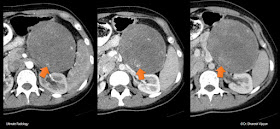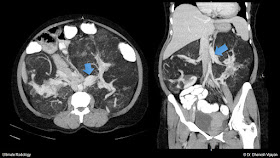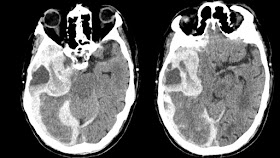Solid Pseudopapillary Tumor (SPT) is a rare, benign, exocrine pancreatic tumor. It is seen in African or Asian females in 2nd or 3rd decade usually. These tumors can be asymptomatic or may present with a gradually enlarging painless mass in abdomen (as in this case), or with vague abdominal pain or discomfort.
SPTs are well encapsulated lesions with varying degrees of hemorrhage, necrosis and cystic degeneration which make them heterogeneous in both plain CT and post contrast images, with hemorrhage and capsule being the most important distinguishing features from other pancreatic neoplasms.
The larger lesions have peripheral solid areas and central necrotic / cystic areas. The smaller or early lesions can be entirely solid, and can be difficult to differentiate from islet cell tumors. Some even can have internal septations in the cystic areas adding to the confusion.
SPTs are usually benign, but occasionally can rarely have local aggressive features, capsular invasion, metastasis(liver), lymphadenopathy. These aggressive tumors are more seen in older patients with a male gender predilection. Benign SPTs are usually completely cured by surgery. Long term survival is better with surgical treatment even in the presence of liver metastasis.1
The following case is a 25yr, female with complaints of feeling of mass in abdomen.
Above CT topogram shows a soft tissue density mass lesion in the left upper quadrant, with compression on stomach and displacing the distal transverse colon and splenic flexure inferiorly. No obvious calcifications detected. No rib erosions / lysis / widening seen. DDs would include Renal, Pancreatic, Adrenal, Gastric lesions. If age is given, possibility of SPT of pancreas should be higher in the list of DDs. This can be a good opening image for FRCR 2B viva discussion.
Plain CT images show heterogenous lesion involving tail of pancreas, showing attenuation values ranging from 15-25HU in hypodense areas and rest showing mostly 40-45HU. No obvious hemorrhagic density was seen. Small areas of capsular calcfications were noted in the posterior aspect mainly.
The classic 'Claw Sign' in Radiology.
Lesion was showing well defined margins, with mass effect on adjacent structures and without any evidence of perilesional infiltration.This was reported as SPT. Patient underwent splenectomy and distal pancreatectomy. Pathology report came as SPT.
References:
1: Solid-pseudopapillary tumor of the pancreas: a surgical enigma?
Martin RC, Klimstra DS, Brennan MF, Conlon KC.
Ann Surg Oncol. 2002 Jan-Feb;9(1):35-40. PubMed PMID: 11833495.
2: Solid Pseudopapillary Tumor of the Pancreas: Typical and Atypical Manifestations.
Jin-Young Choi, Myeong-Jin Kim, Joo Hee Kim, Seung Hyoung Kim, Joon Sok Lim, Young Taik
Oh, Jae-Joon Chung, Hyung Sik Yoo, Jong Tae Lee, and Ki Whang Kim.
American Journal of Roentgenology 2006 187:2, W178-W186.
3: Solid-Pseudopapillary Tumor of the Pancreas.
Kristin M. Coleman, Michael C. Doherty, and Steven A. Bigler.
RadioGraphics 2003 23:6, 1644-1648.
4. CT and MRI of the Whole Body, John.R.Haaga, 6th Edition.




















